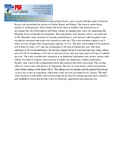Role of Bryophytes and Tree Canopy in Mist Trapping in Mt. Marsabit Forest

Date
2014Author
Muchura, H M
Min, S
Mworia, J K
Gichuki, N N
Language
enMetadata
Show full item recordAbstract
Mt. Marsabit forest, is an isolated Tropical Rain Forest, oasis, located 560 Km north of Nairobi, Kenya; and
surrounded by deserts of Chalbi, Kaisut and Bubisa. The forest is under threat mainly by anthropogenic effects
before the forest biota is studied. This research was to investigate the role of bryophytes and forest canopy in
trapping mist water, for supporting Mt. Marsabit forest community development. The experiments were located
1450 m. asl windward of Mt. Marsabit. Stem simulates of varying circumferences were dressed with bryophytes
and bryophytes mounted mist traps were located on same site. The water retention capacity was 6 times own dry
weight with a hygroscopic capacity of 13%. The mist water trapped by bryophytes was 8 liters of water / m ²/
mist day translating to 196 mm of rainfall per year. The stem simulates of 20 cm circumference, 50 cm long
trapped 30 ml of water per mist day using surface area of 0.05 m² translating to 914 ml of water per m² per mist
day equivalent to 65 mm of rainfall per year. The study revealed that vegetation is an important catchments area
surface (attract rain) whose loss leads to reduced water resource for plant and animal use; climate moderation.
Further, mist water is the compensation factor that supports the forest ecosystem. The cooling effect of water is
lost with the loss of vegetation. The loss of water leads to drier environment with climate change as the ripple
effect. The change in river regimes and the general hydrologic cycle is due to loss in vegetation, where mist
water was not accounted for by science. The mist water resource is renewable water resource that can be used to
recharge ground water, conserve and rehabilitate forest and provide water for domestic, agricultural and
industrial use.
Citation
Muchura, H. M., Min, S., Mworia, J. K., & Gichuki, N. N. (2014). Role of Bryophytes And Tree Canopy In Mist Trapping In Mt. Marsabit Forest. Journal of Environment and Earth Science, 4(21), 128-138.Publisher
University of Nairobi
